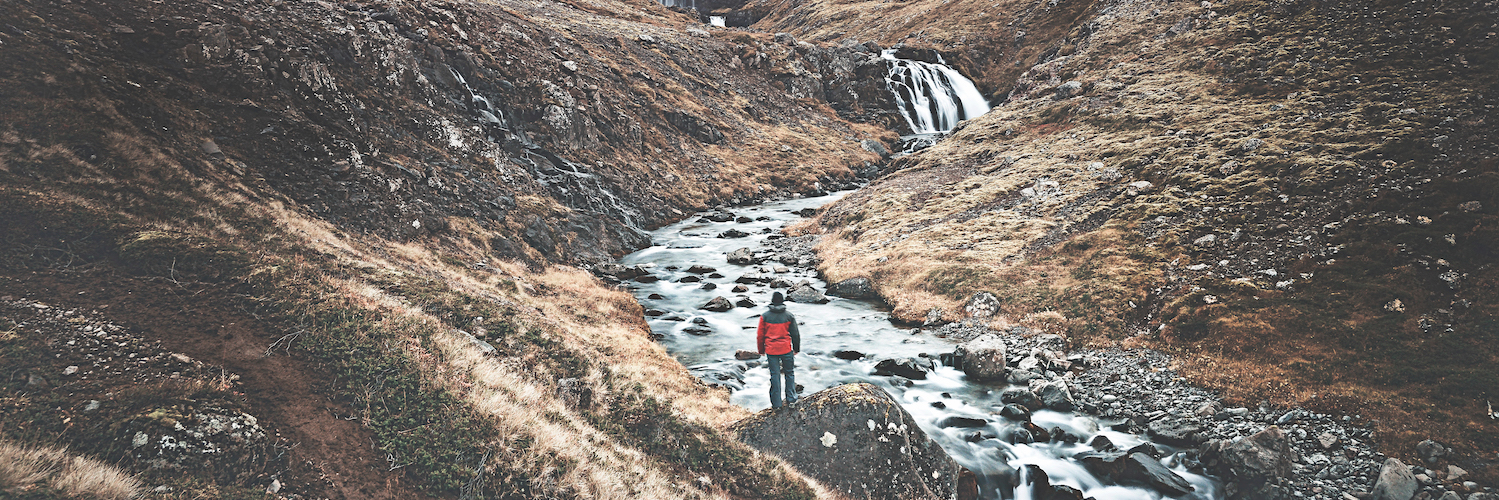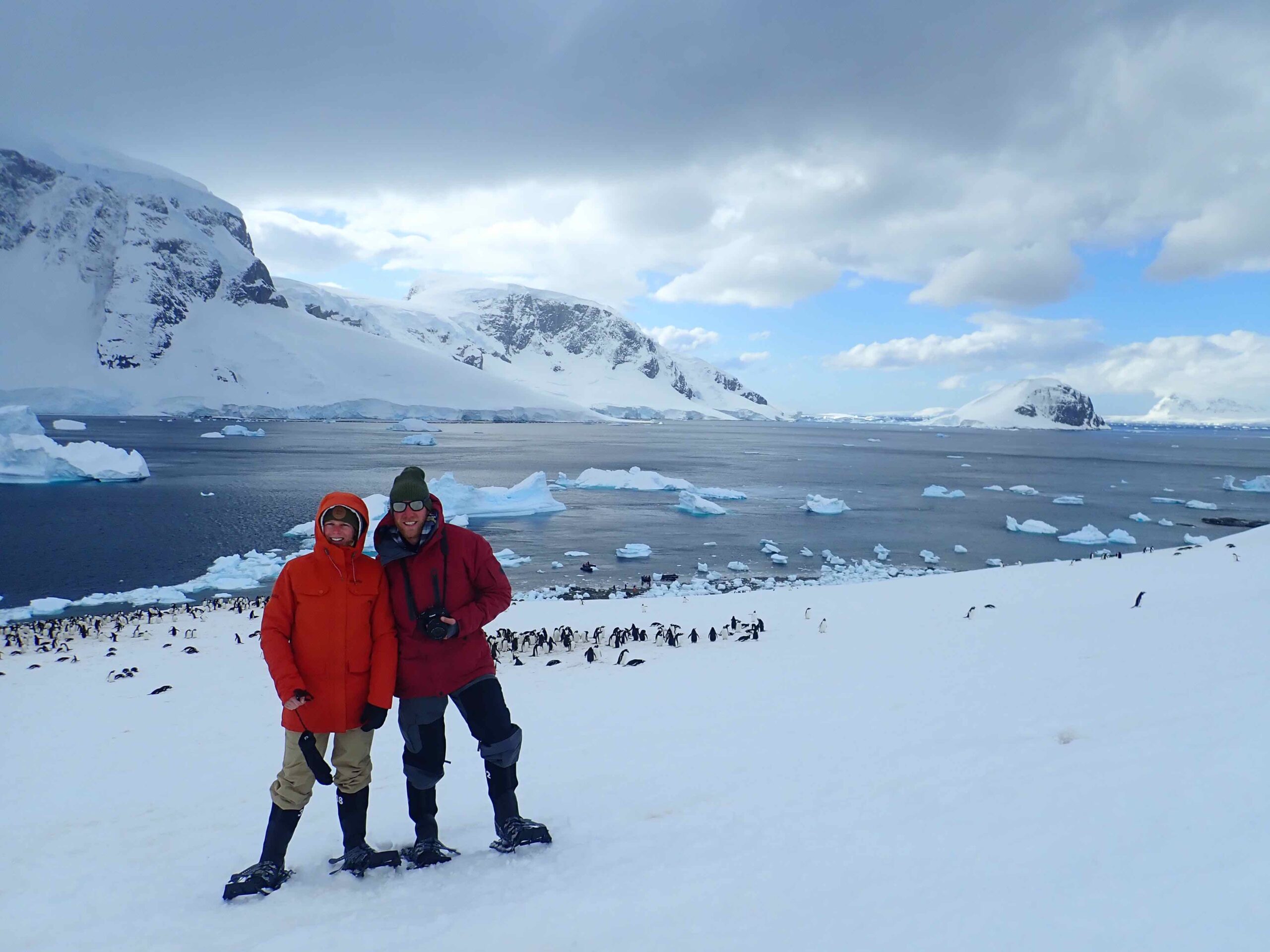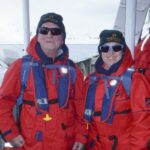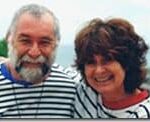
Explore the ‘Land of Ice and Fire’ where snow-capped peaks rise above glaciers and active volcanoes rumble. Walk along a black sand beach strewn with glittering bergy bits and discover geysers and fumaroles and bubbling mud pools, or explore spectacular fjords and impressive waterfalls, in one of the most geologically active places on earth. Our specialist naturalists and historians will reveal the Iceland below the surface – a land rich in wildlife, culture and fascinating human history.
Important Note: in order to experience some of Iceland’s incredible scenery, a number of the shore excursions on this itinerary require overland coach travel away from the coast.
This is an example itinerary. Please contact us for the specific details of each itinerary, depending on the departure date and duration.
Arrive in Reykjavik and transfer to our group hotel. Upon check-in at Fosshotel Reykjavik, reception staff will provide your cabin tags. Please fill out the luggage tags clearly, showing your name and cabin number to allow us to deliver your luggage to your cabin. At tonight’s voyage briefing, enjoy a welcome drink and meet fellow expeditioners.
Accommodation: Fosshotel Reykjavik (or similar)
After breakfast at the hotel, a transfer is included to the pier to board our ship the Greg Mortimer. Sail into Hvalfjördur, a beautiful fjord just north of Reykjavik with wide areas of flat verdant land along majestic mountains, and beaches cut with creeks. The fjord is approximately 30 km / 19 mi long and 5 km / 3 miles wide. The area is rich in bird life and is home to seals, perfect for Zodiac cruising, kayaking and hikes.
Historically, Hvalfjörður was home to one of the main whaling stations in Iceland, with ships heading out into Faxaflói Bay. It was one of the most important naval stations in the North Atlantic during World War II, when Iceland was occupied by the Allies after the Nazis conquered Denmark. The old whaling station and a war museum can be found in the fjord.
Stykkisholmur is the starting point of our adventures on the Snaefellsnes Peninsula, gateway Snæfellsjökull National Park. Stykkishólmur is located by Breiðafjörður Bay on the north of Snæfellsnes peninsula and is surrounded by wonderful views of the innumerable islands. One of the defining landmarks in Stykkishólmur are the old houses in the old city centre, some of which were owned by Danish traders, and every year in August there is a Danish town festival in Stykkishólmur called Danskir dagar or Danish days. The oldest house in Stykkishólmur is the Norwegian house, which dates back to 1832. The inhabitants take great pride in preserving the old houses and walking in the centre of town is like walking in another era.
An area of diverse landscapes, characterised by lava fields and glistening fjords and home to bird-rich Breidafjordur Bay. The area is crowned by the magnificent, ice-capped Snæfellsjökull volcano, a 700,000-year-old dormant subglacial volcano, visible from Reykjavik on a clear day and immortalised in Jules Verne’s Journey to the Centre of the Earth.
Disembark the ship at approximately 8.30 am to commence today’s full day (7 hours) excursion visiting the following areas:
Arnarstapi was an important trading post in the past and had a much bigger population than it has now. Columnar basalt, ravines and grottoes surround the Arnarstapi pier. There is a large arctic tern colony in the village itself, and a walk along the coastline is a great way to see birds such as kittiwake, Arctic tern and fulmar. You will also pass magnificent lava formations. The seaside and the cliffs between Arnastapi and Hellnar were made a Natural Reserve in 1979. A sculpture of Bardur Snaefellsas by Ragnar Kjartansson stands by the beach at Arnarstapi.
At Bjarnarhöfn you will enjoy a guided tour of the shark museum and have the opportunity to taste the famed cured shark.
Though Grundarfjörður is not the most well-known town in Snæfellsnes, Mount Kirkjufell is certainly one of the most famous mountains in Iceland, if not the world. It is not unusual for photographers from all over the world to make their way to Grundarfjörður for the sole purpose of photographing this unique landmark which has even starred in a number of films. However, there is a lot more on offer in Grundarfjörður than just Mount Kirkjufell. Nature abounds, with vibrant birdlife and spectacular waterfalls.
En route to Isafjordur, we sail past the immense Látrabjarg cliffs, Iceland’s westernmost point and home to a huge population of razorbills and puffins.
Over the next two days, explore the Westfjords region featuring outstanding landscapes with jaw-dropping views of dramatic fjords carved by ancient glaciers, sheer table mountains that plunge into the sea and pristine North Atlantic vegetation. The region features attractive towns such as Isafjordur, the famous Dynjandi waterfall, and spectacular fjords offering kayaking excursions, hiking trails, and bird-watching.
In genuine expeditionary style, we keep our itinerary flexible to allow for spontaneity. We plan to visit Hornstrandir peninsula, one of Iceland’s remotest and most pristine regions filled with many deep and dramatic fjords, towering bird cliffs, stunning natural beauty and opportunities for wildlife encounters. Enjoy the bountiful silence and magnificent landscapes seen by the few adventurers that make their way here.
Picturesque Akureyri is Iceland’s second largest city outside the capital area with a superb snow-capped mountain backdrop. Explore the old town, with its beautifully maintained period houses before heading inland to nearby Mývatn region – an area said to be the most geologically active area in Iceland.
Shore Excursions (choose one of the following):
Option One (up to 9 hours)
The Goðafoss waterfall is one of the most spectacular waterfalls in Iceland. In the year 1,000 the Lawspeaker Þorgeir Ljósvetningagoði made Christianity the official religion of Iceland. After his conversion, Þorgeir threw his statues of the Norse gods into the waterfall earning the waterfall its name – waterfall of the gods.
Námaskarð is well-known for its sulphurous mud springs called solfataras and steam springs called fumaroles. Even though you won’t find any pure spring water in this wonderful geothermal site of Iceland, the beauty of the colourful minerals and the gigantic mud craters are truly impressive.
Dettifoss is a waterfall in northeast Iceland and is reputed to be the most powerful waterfall in Europe. The falls are 100 metres / 328 feet wide and have a drop of 44 metres / 144 feet down to the Jökulsárgljúfur canyon.
Ásbyrgi is a forested horse-shoe shaped canyon in Oxarfjordur. Asbyrgi is a part of Jökulsárgljúfur, within the Vatnajökull National Park.
Option two (up to 7-8 hours)
Akureyri Public Parkand Botanic Garden – The garden is one of the northern most botanical gardens in the world. The Public Park was opened in 1912 but the botanic gardens section was open in 1957. There are about 6,600 different species of plants grown in the garden, of which, 430 species are native to Iceland.
The Goðafoss waterfall is one of the most spectacular waterfalls in Iceland. In the year 1,000 the Lawspeaker Þorgeir Ljósvetningagoði made Christianity the official religion of Iceland. After his conversion, Þorgeir threw his statues of the Norse gods into the waterfall earning the waterfall its name – waterfall of the gods.
Dimmuborgir is an area of strewn with enormous lava rocks and cliffs. The formation of these extraordinary lava cliffs and pillars are the result of molten lava flowing over a pond in the eruption of Lúdentsborgir and Þrengslaborgir some 2,300 years ago. The most famous of these formations is “The Church”, aptly named, as this is a cave, open at both ends and with a dome-like ceiling.
Námaskarð earns its well-known for its sulphurous mud springs called solfataras and steam springs called fumaroles. Even though you won’t find any pure spring water in this wonderful geothermal site of Iceland, the beauty of the colourful minerals is impressive and the gigantic mud craters are truly impressive.
Mývatn Nature Baths: Drawing on a centuries-old tradition, the tastefully designed complex offers bathers a completely natural experience that begins with a relaxing dip amidst clouds of steam rising up from a fissure deep in the Earth´s surface, and ends with a luxurious swim in a pool of geothermal water drawn from depths of up to 2,500 metres / 8,200 feet.
Both options will end with a transfer to Húsavik, where you can explore the small town at your own leisure before reboarding the ship to sail to Grímsey Island.
Located approximately 40 km (25 miles) off the mainland, Grímsey is a verdant grassy island, probably best known for its proximity to the Arctic Circle, which cuts across the island. Many people travel to Grímsey just to say they have stepped across the imaginary line. With a tiny population of approximately 100 inhabitants, it’s a fantastic place for Zodiac cruising, kayaking, and photographing seabirds such as guillemots, gulls and puffins.
Leaving Grímsey to return closer to the mainland, we spend time scanning the waters of Skjálfandi Bay around Húsavik, a town known as the Iceland’s ‘whale watching capital’, home to up to 24 different whale species, as well as dolphins and 30 variety of birds. The largest animal on earth, the blue whale, has also been spotted in Skjálfandi Bay, and if you are lucky, you might catch a glimpse of this magnificent creature as well as others, such as orcas, fin whales and pilot whales.
Mjóifjördur (meaning narrow fjord) is an 18 km / 11 mile fjord on Iceland’s east coast length is a little-known gem cherished by locals. Hidden between Nordfjördur and Seydisfjördur mountains that provide shelter and pleasant weather, the fjord is known by locals as an excellent place to soak in the peaceful surroundings and for its spectacular waterfalls – ideal for kayaking and Zodiac cruising.
Mjóifjörður is an exceptionally beautiful, tranquil and remote area with spectacular cliffs, and because of the fjord’s still weather it has lush green hills and exceptionally rich flora lining its shores. It also has the impressive Prestagil (The Priest’s Ravine) and the Hofsárgljúfur Canyon with delightful rivers and waterfalls. If it weren’t for the weekly ferry that comes here once a week in the winter, the local people would be completely isolated. At Asknes are the remains of an old whaling station, the largest in the world at the time, built by the Norwegians around 1900, with over 200 hundred workers. Today, on the way to the tiny village, Brekkuþorp, where only about 20 people live, a shipwreck on the shore acts as a haunting reminder of the town’s whaling past.
Höfn is a lively fishing town with a healthy population of 1,800, and gateway to Vatnajökull National Park – one of the most spectacular and special parts of Iceland, home to Europe’s largest glacier, Vatnajökull – our shore excursion for the day. We’ll also hike in Skaftafell National Park, which was established in 1967, but from 2008 it became part of the larger Vatnajökull National Park, Europe’s second largest after Yugyd Va in Russia. The park also boasts colourful mountains and deep valleys, as well as rich birdlife, reindeers and seals.
Inside the national park you can find glacier tongues resting on the green fields of the lowland, Jökulsárlón glacier lagoon, a glacial lagoon filled with floating icebergs that wash up on shore and stand gleaming on the nearby black-sand beach, dubbed Diamond beach. Enjoy an amphibian boat excursion on the lagoon to photograph the icebergs.
Located off Iceland’s south coast, the Westman Islands (Vestmannaeyjar) were formed by volcanic eruptions around 10,000 years ago. Sail past Surtsey Island, a UNESCO World Heritage site that emerged from the sea in 1963 and is one the youngest land masses on earth. Westman Islands are surrounded by 15 other uninhabited islands and around 30 rocks and skerries offering refuge for rich array of seabirds. Westman Islands are considered to have the largest Atlantic puffin colony in the world, and when sailing around the islands it is not uncommon to see puffins but also whales and seals.
Heimaey is the main island in the archipelago and it has the population of around 4,200. Ashore on Heimaey, the only inhabited island in the archipelago, we see half-buried houses that remain from a violent 1973 eruption of Eldfell volcano, which you can hike up if you wish. A visit to the weather station offers bird-watching opportunities and splendid views of the surrounding islands.
Eruptions are a big part of the history of the Westman Island, where there are two volcanoes – one that erupted some 6,000 years ago, and Mount Eldfell that erupted in 1973, forcing all of the island’s inhabitants to evacuate for the mainland. Serendipitously, due to bad weather the day prior to the eruption, all the fishing boats remained in the harbour and were able to help transport Heimaey’s inhabitants to the mainland. You can learn more about the story of the eruption and the aftermath at the fascinating Eldheimar museum, which includes a display of a house that was buried in ash during the eruption.
After breakfast, bid farewell to the expedition team, crew and newfound friends as you disembark in Reykjavik, and transfer to downtown Reykjavik or to Keflavik airport to continue your journey.
NOTE: At the conclusion of the voyage, we do not recommend booking flights departing prior to 12.00 pm on the day of disembarkation in case there are delays.
Important note: In the spirit of expedition travel, we encourage exploration and adventure offering flexibility in challenging environments. This itinerary is only a guide and is subject to change due to weather, sea and other conditions beyond our control.
Wow, wow and wow! What an amazing experience we had with Ice Tracks. We have a smile on our faces from ear to ear.
Many thanks to the team! You informed us so completely, so honestly and shared your own experiences what made us feel assured. Your enthusiasm made us feel excited from the first moment we had contact, even till now when we share our voyage with friends and family. For us this trip was the closure of a backpacking voyage, which we started in Mexico. The vessel and expedition team made us feel like part of the family during 11 days. Our room was spacious and clean. Staff and food were great. The lectures during days at sea were nice. This once in a lifetime experience was mind blowing!
Monique and Steve from Belgium traveled with us to the Antarctic Peninsula

How do you describe it all to people that were not there? I’ve found it difficult, but very willing to try. Well, in retelling the (fairy) tale the last few days, the highlights are starting to cement in together with some new friendships!
· The hair-raising off-roading trip to the lake
· That amazing Argentinian braai in the woods & the beautiful snowy wonderland around us.
· To see how much Brian enjoys ships (although saying what a lovely cruise it was coming back, while some were dreadfully sick – he was perhaps living dangerously!)
· The first sighting of that whiter than white …
· The crystal, crystal clear waters
· My excitement at the first landing on the iced, uninhabited continent
· The colours & the moods & the vastness!
· Our South Africans taking the first dive in that colder than cold water!!!
· The amazing strength & stamina of those penguins. I do tell the tale of the solitary soul waiting to greet those mountaineers at the top of Spiget!
· The comraderie in our group
· Our “tea break” on the zodiac with irish coffee & green tea – where Caro asked Chicken to “duck”!
· The photo of the campers sitting around the “campfire” was an absolute winner …
· The soft snow on our last landing & trying to walk in that!
We reiterate our thanks to Mandy, Guts & Caro – you put a huge amount of work into making it a dream holiday for us – and it was, & we are truly grateful.

We are now back indeed, and slowly coming to grips with the ‘real’ world. As you may imagine, there is little one can really say about Antarctica of which you are not fully aware. If it were in any way possible I for one would never go anywhere else on this planet. Ute had reservations about going South as she does not like the cold, but after our experience in Patagonia in southern Chile and Argentina, she also wanted to be in the pure untainted and pristine world of Antarctica. Now Ute even says she could happily go back. Unfortunately, we can only be very thankful that we even once had the opportunity to make this dream come true. Thank you very much for your part in making that happen. We were cared for graciously by Ice Tracks and without their expert and very able assistance our trip might never have taken place. I warmly recommend Ice Tracks guidance to anyone wishing to go South. The whole experience we had was more akin to friendship than business, and we do hope that we may one day meet again on the high seas!

| Cookie | Duration | Description |
|---|---|---|
| cookielawinfo-checkbox-analytics | 11 months | This cookie is set by GDPR Cookie Consent plugin. The cookie is used to store the user consent for the cookies in the category "Analytics". |
| cookielawinfo-checkbox-functional | 11 months | The cookie is set by GDPR cookie consent to record the user consent for the cookies in the category "Functional". |
| cookielawinfo-checkbox-necessary | 11 months | This cookie is set by GDPR Cookie Consent plugin. The cookies is used to store the user consent for the cookies in the category "Necessary". |
| cookielawinfo-checkbox-others | 11 months | This cookie is set by GDPR Cookie Consent plugin. The cookie is used to store the user consent for the cookies in the category "Other. |
| cookielawinfo-checkbox-performance | 11 months | This cookie is set by GDPR Cookie Consent plugin. The cookie is used to store the user consent for the cookies in the category "Performance". |
| viewed_cookie_policy | 11 months | The cookie is set by the GDPR Cookie Consent plugin and is used to store whether or not user has consented to the use of cookies. It does not store any personal data. |
